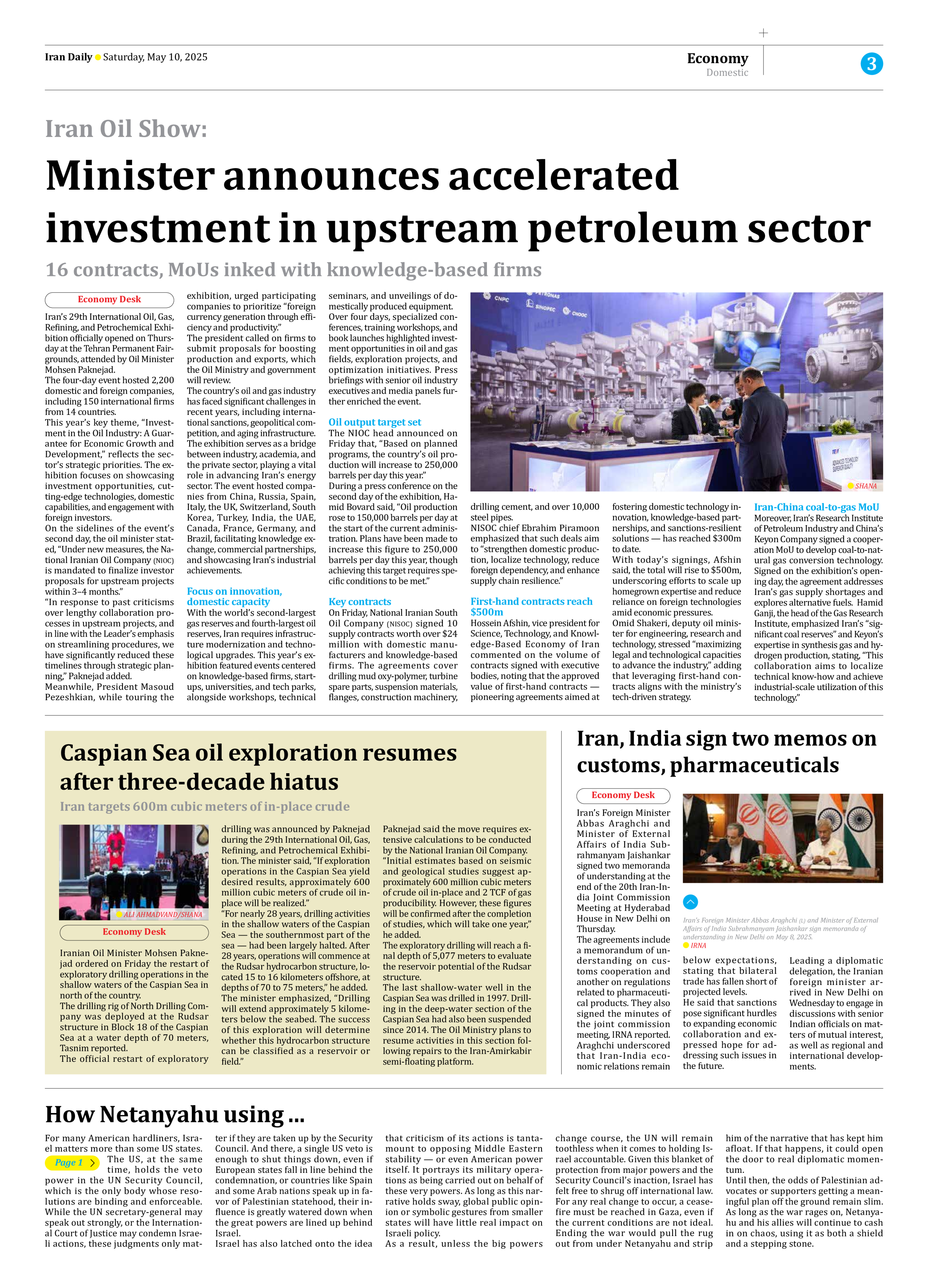
Iran Oil Show:
Minister announces accelerated investment in upstream petroleum sector
16 contracts, MoUs inked with knowledge-based firms
Iran’s 29th International Oil, Gas, Refining, and Petrochemical Exhibition officially opened on Thursday at the Tehran Permanent Fairgrounds, attended by Oil Minister Mohsen Paknejad.
The four-day event hosted 2,200 domestic and foreign companies, including 150 international firms from 14 countries.
This year’s key theme, “Investment in the Oil Industry: A Guarantee for Economic Growth and Development,” reflects the sector’s strategic priorities. The exhibition focuses on showcasing investment opportunities, cutting-edge technologies, domestic capabilities, and engagement with foreign investors.
On the sidelines of the event’s second day, the oil minister stated, “Under new measures, the National Iranian Oil Company (NIOC) is mandated to finalize investor proposals for upstream projects within 3–4 months.”
“In response to past criticisms over lengthy collaboration processes in upstream projects, and in line with the Leader’s emphasis on streamlining procedures, we have significantly reduced these timelines through strategic planning,” Paknejad added.
Meanwhile, President Masoud Pezeshkian, while touring the exhibition, urged participating companies to prioritize “foreign currency generation through efficiency and productivity.”
The president called on firms to submit proposals for boosting production and exports, which the Oil Ministry and government will review.
The country’s oil and gas industry has faced significant challenges in recent years, including international sanctions, geopolitical competition, and aging infrastructure. The exhibition serves as a bridge between industry, academia, and the private sector, playing a vital role in advancing Iran’s energy sector. The event hosted companies from China, Russia, Spain, Italy, the UK, Switzerland, South Korea, Turkey, India, the UAE, Canada, France, Germany, and Brazil, facilitating knowledge exchange, commercial partnerships, and showcasing Iran’s industrial achievements.
Focus on innovation, domestic capacity
With the world’s second-largest gas reserves and fourth-largest oil reserves, Iran requires infrastructure modernization and technological upgrades. This year’s exhibition featured events centered on knowledge-based firms, startups, universities, and tech parks, alongside workshops, technical seminars, and unveilings of domestically produced equipment.
Over four days, specialized conferences, training workshops, and book launches highlighted investment opportunities in oil and gas fields, exploration projects, and optimization initiatives. Press briefings with senior oil industry executives and media panels further enriched the event.
Oil output target set
The NIOC head announced on Friday that, “Based on planned programs, the country’s oil production will increase to 250,000 barrels per day this year.”
During a press conference on the second day of the exhibition, Hamid Bovard said, “Oil production rose to 150,000 barrels per day at the start of the current administration. Plans have been made to increase this figure to 250,000 barrels per day this year, though achieving this target requires specific conditions to be met.”
Key contracts
On Friday, National Iranian South Oil Company (NISOC) signed 10 supply contracts worth over $24 million with domestic manufacturers and knowledge-based firms. The agreements cover drilling mud oxy-polymer, turbine spare parts, suspension materials, flanges, construction machinery, drilling cement, and over 10,000 steel pipes.
NISOC chief Ebrahim Piramoon emphasized that such deals aim to “strengthen domestic production, localize technology, reduce foreign dependency, and enhance supply chain resilience.”
First-hand contracts reach $500m
Hossein Afshin, vice president for Science, Technology, and Knowledge-Based Economy of Iran commented on the volume of contracts signed with executive bodies, noting that the approved value of first-hand contracts — pioneering agreements aimed at fostering domestic technology innovation, knowledge-based partnerships, and sanctions-resilient solutions — has reached $300m to date.
With today’s signings, Afshin said, the total will rise to $500m, underscoring efforts to scale up homegrown expertise and reduce reliance on foreign technologies amid economic pressures.
Omid Shakeri, deputy oil minister for engineering, research and technology, stressed “maximizing legal and technological capacities to advance the industry,” adding that leveraging first-hand contracts aligns with the ministry’s tech-driven strategy.
Iran-China coal-to-gas MoU
Moreover, Iran’s Research Institute of Petroleum Industry and China’s Keyon Company signed a cooperation MoU to develop coal-to-natural gas conversion technology. Signed on the exhibition’s opening day, the agreement addresses Iran’s gas supply shortages and explores alternative fuels. Hamid Ganji, the head of the Gas Research Institute, emphasized Iran’s “significant coal reserves” and Keyon’s expertise in synthesis gas and hydrogen production, stating, “This collaboration aims to localize technical know-how and achieve industrial-scale utilization of this technology.”







